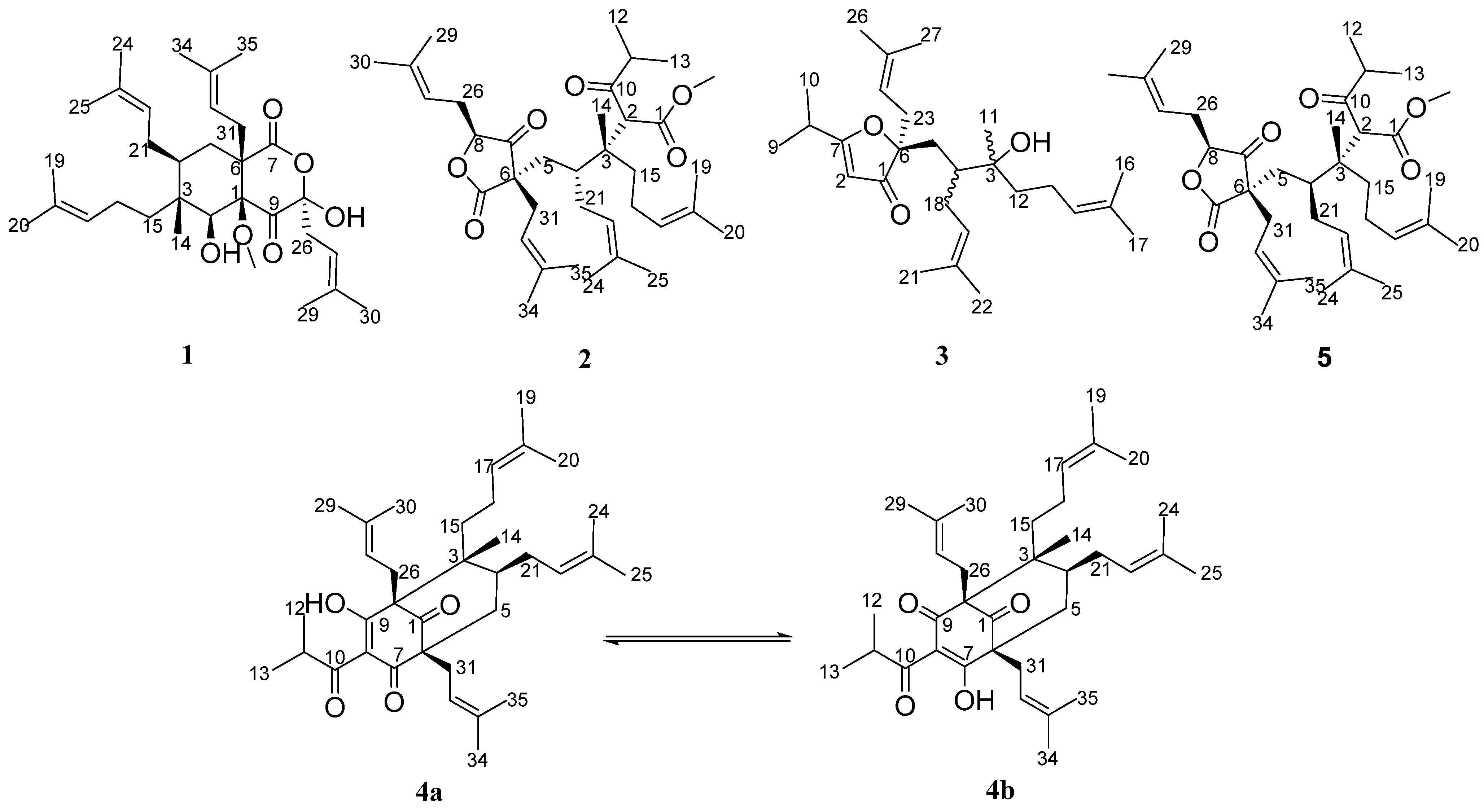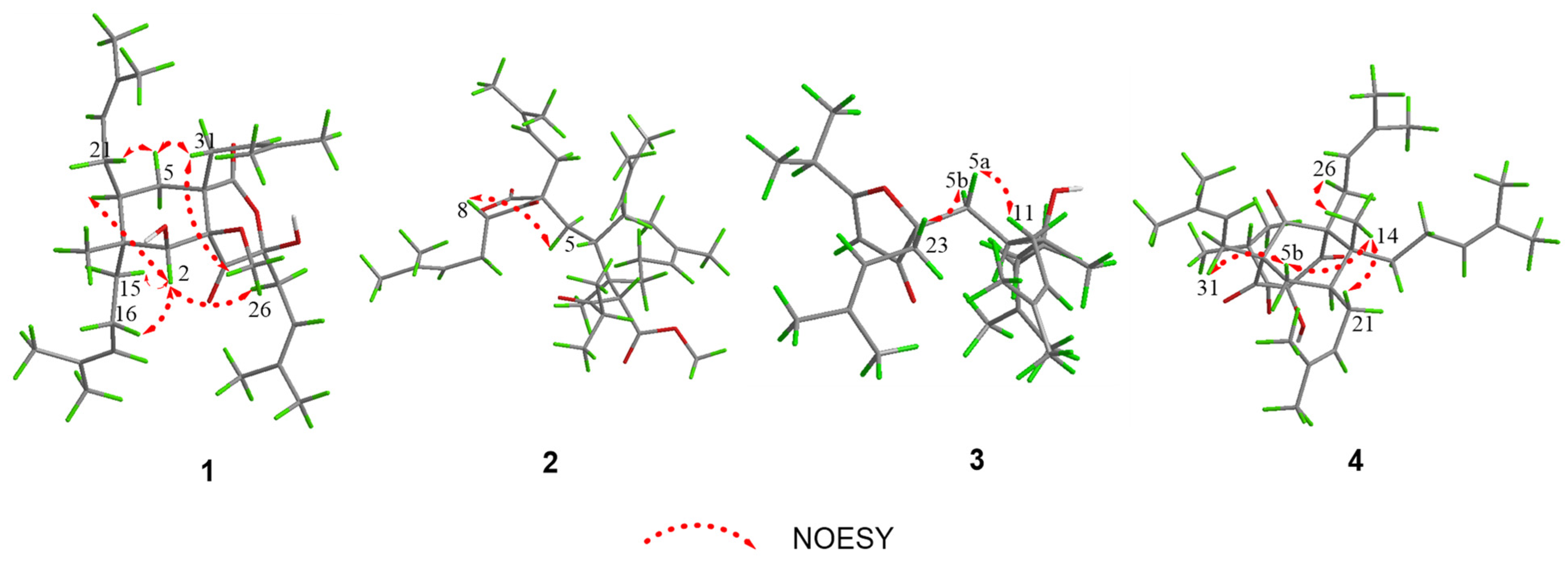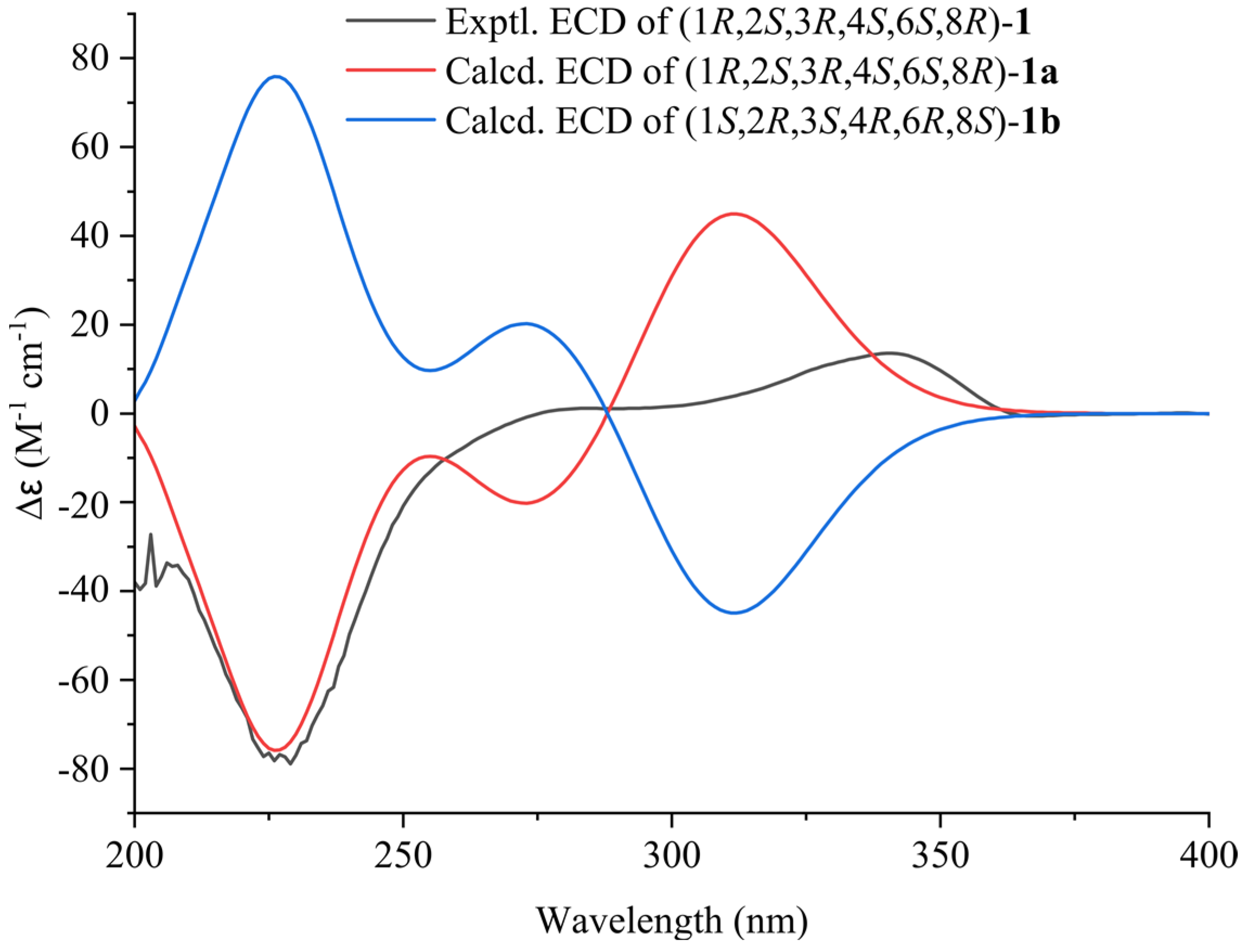Four New Polyprenylated Acylphloroglucinols from Hypericum perforatum L.
Abstract
1. Introduction
2. Results and Discussion
3. Materials and Methods
3.1. General
3.2. Plant Materials
3.3. Extraction and Isolation
3.4. Structural Elucidation
3.5. Cell Culture
3.6. Measurement of Nitric Oxide (NO) Production
3.7. Statistical Analysis
4. Conclusions
Supplementary Materials
Author Contributions
Funding
Institutional Review Board Statement
Informed Consent Statement
Data Availability Statement
Acknowledgments
Conflicts of Interest
References
- Bridi, H.; Meirelles, G.d.C.; von Poser, G.L. Structural Diversity and Biological Activities of Phloroglucinol Derivatives from Hypericum Species. Phytochemistry 2018, 155, 203–232. [Google Scholar] [CrossRef]
- Zhang, R.; Ji, Y.; Zhang, X.; Kennelly, E.J.; Long, C. Ethnopharmacology of Hypericum Species in China: A Comprehensive Review on Ethnobotany, Phytochemistry and Pharmacology. J. Ethnopharmacol. 2020, 254, 112686. [Google Scholar] [CrossRef] [PubMed]
- Korczak, M.; Pilecki, M.; Granica, S.; Gorczynska, A.; Pawłowska, K.A.; Piwowarski, J.P. Phytotherapy of mood disorders in the light of microbiota-gut-brain axis. Phytomedicine 2023, 111, 154642. [Google Scholar] [CrossRef] [PubMed]
- Suryawanshi, M.V.; Gujarathi, P.P.; Mulla, T.; Bagban, I. Hypericum perforatum: A comprehensive review on pharmacognosy, preclinical studies, putative molecular mechanism, and clinical studies in neurodegenerative diseases. Naunyn-Schmiedeberg’s Arch. Pharmacol. 2024. [Google Scholar] [CrossRef]
- Knauthe, A.; Mittag, S.; Bloch, L.; Albring, K.F.; Schmidt, M.; Werz, O.; Huber, O. Hyperforin and Myrtucommulone Derivatives Act as Natural Modulators of Wnt/β-Catenin Signaling in HCT116 Colon Cancer Cells. Int. J. Mol. Sci. 2022, 23, 2984. [Google Scholar] [CrossRef] [PubMed]
- Tsioutsiou, E.E.; Amountzias, V.; Vontzalidou, A.; Dina, E.; Stevanović, Z.D.; Cheilari, A.; Aligiannis, N. Medicinal Plants Used Traditionally for Skin Related Problems in the South Balkan and East Mediterranean Region-A Review. Front. Pharmacol. 2022, 13, 936047. [Google Scholar] [CrossRef] [PubMed]
- Duan, Y.; Deng, Y.; Bu, P.; Guo, Y.; Shi, Z.; Cao, Y.; Zhang, Y.; Hu, H.; Hu, Z.; Qi, C.; et al. Discovery of Bioactive Polycyclic Polyprenylated Acylphloroglucinols from Hypericum wilsonii. Bioorg. Chem. 2021, 115, 105246. [Google Scholar] [CrossRef] [PubMed]
- Guo, Y.; Zhang, N.; Chen, C.; Huang, J.; Li, X.N.; Liu, J.; Zhu, H.; Tong, Q.; Zhang, J.; Luo, Z.; et al. Tricyclic Polyprenylated Acylphloroglucinols from St John’s Wort, Hypericum perforatum. J. Nat. Prod. 2017, 80, 1493–1504. [Google Scholar] [CrossRef] [PubMed]
- Lou, H.Y.; Li, Y.N.; Yi, P.; Jian, J.Y.; Hu, Z.X.; Gu, W.; Huang, L.J.; Li, Y.M.; Yuan, C.M.; Hao, X.J. Hyperfols A and B: Two Highly Modified Polycyclic Polyprenylated Acylphloroglucinols from Hypericum perforatum. Org. Lett. 2020, 22, 6903–6906. [Google Scholar] [CrossRef]
- Smelcerovic, A.; Spiteller, M.; Zuehlke, S. Comparison of Methods for the Exhaustive Extraction of Hypericins, Flavonoids, and Hyperforin from Hypericum perforatum L. J. Agric. Food Chem. 2006, 54, 2750–2753. [Google Scholar] [CrossRef]
- Orčić, D.Z.; Mimica-Dukić, N.M.; Francišković, M.M.; Petrović, S.S.; Jovin, E.Đ. Antioxidant Activity Relationship of Phenolic Compounds in Hypericum perforatum L. Chem. Cent. J. 2011, 5, 34. [Google Scholar] [CrossRef] [PubMed]
- Xu, Z.H.; Grossman, R.B.; Qiu, Y.F.; Luo, Y.; Lan, T.; Yang, X.W. Polycyclic Polyprenylated Acylphloroglucinols Bearing a Lavandulyl-Derived Substituent from Garcinia Xanthochymus Fruits. J. Nat. Prod. 2022, 85, 2845–2855. [Google Scholar] [CrossRef] [PubMed]
- Lou, H.; Ma, F.; Yi, P.; Hu, Z.; Gu, W.; Huang, L.; He, W.; Yuan, C.; Hao, X. Bioassay and UPLC-Q-Orbitrap-MS/MS Guided Isolation of Polycyclic Polyprenylated Acylphloroglucinols from St. John’s Wort and Their Neuroprotective Activity. Arab. J. Chem. 2022, 15, 104057. [Google Scholar] [CrossRef]
- Guo, Y.; Huang, F.; Sun, W.; Zhou, Y.; Chen, C.; Qi, C.; Yang, J.; Li, X.N.; Luo, Z.; Zhu, H.; et al. Unprecedented Polycyclic Polyprenylated Acylphloroglucinols with Anti-Alzheimer’s Activity from St. John’s Wort. Chem. Sci. 2021, 12, 11438–11446. [Google Scholar] [CrossRef] [PubMed]
- Xie, J.Y.; Li, P.F.; Yan, X.T.; Gao, J.M. Discovery from Hypericum elatoides and synthesis of hyperelanitriles as α-aminopropionitrile-containing polycyclic polyprenylated acylphloroglucinols. Commun. Chem. 2024, 7, 1. [Google Scholar] [CrossRef]
- Yan, X.T.; Chen, J.X.; Wang, Z.X.; Zhang, R.Q.; Xie, J.Y.; Kou, R.W.; Zhou, H.F.; Zhang, A.L.; Wang, M.C.; Ding, Y.X.; et al. Hyperhubeins A–I, Bioactive Sesquiterpenes with Diverse Skeletons from Hypericum hubeiense. J. Nat. Prod. 2023, 86, 119–130. [Google Scholar] [CrossRef] [PubMed]
- Verotta, L.; Lovaglio, E.; Sterner, O.; Appendino, G.; Bombardelli, E. Modulation of Chemoselectivity by Protein Additives. Remarkable Effects in the Oxidation of Hyperforin. J. Org. Chem. 2004, 69, 7869–7874. [Google Scholar] [CrossRef] [PubMed]
- Niwa, K.; Tanaka, N.; Tatano, Y.; Yagi, H.; Kashiwada, Y. Hypascyrins A-E, Prenylated Acylphloroglucinols from Hypericum ascyron. J. Nat. Prod. 2019, 82, 2754–2760. [Google Scholar] [CrossRef] [PubMed]
- Albernaz, L.C.; Deville, A.; Dubost, L.; de Paula, J.E.; Bodo, B.; Grellier, P.; Espindola, L.S.; Mambu, L. Spiranthenones A and B, Tetraprenylated Phloroglucinol Derivatives from the Leaves of Spiranthera Odoratissima. Planta. Med. 2012, 78, 459–464. [Google Scholar] [CrossRef]
- Sultana, N.; Saify, Z.S.; Saleem, M.; Kamal, M. Two new triterpenes from Alstonia scholaris flowers. Nat. Prod. Res. 2013, 27, 1277–1286. [Google Scholar] [CrossRef]
- Yamashita, H.; Matsuzaki, M.; Kurokawa, Y.; Nakane, T.; Goto, M.; Lee, K.H.; Shibata, T.; Bando, H.; Wada, K. Four New Triterpenoids from the Bark of Euonymus Alatus Forma Ciliato-Dentatus. Phytochem. Lett. 2019, 31, 140–146. [Google Scholar] [CrossRef] [PubMed]
- Seo, D.G.; Kim, S.; Lee, D.K.; Kim, N.Y.; Lee, J.S.; Hwang, K.W.; Park, S.Y. Inhibitory Effect of α-Amyrin Acetate Isolated from Fraxinus Rhynchophylla on Th17 Polarization. Phytomedicine 2019, 63, 153056. [Google Scholar] [CrossRef] [PubMed]
- Takeoka, G.; Dao, L.; Teranishi, R.; Wong, R.; Flessa, S.; Harden, L.; Edwards, R. Identification of Three Triterpenoids in Almond Hulls. J. Agric. Food Chem. 2000, 48, 3437–3439. [Google Scholar] [CrossRef]
- Aung, H.T.; Aye, M.M.; Thu, Z.M.; Komori, Y.; Sein, M.M.; Vidari, G.; Takaya, Y. Bioactive Constituents from the Rhizomes of Sansevieria Cylindrica. Rec. Nat. Prod. 2020, 14, 269–275. [Google Scholar] [CrossRef]
- Panyasawat, P.; Wisetsai, A.; Lekphrom, R.; Senawong, T.; Schevenels, F.T. Acroquinolones A and B, two polyphenolic isoprenylated acetophenone-quinolone hybrids with anti-proliferative activities from Acronychia pedunculata (L.) Miq. Nat. Prod. Res. 2022, 36, 2743–2752. [Google Scholar]
- Chaturvedula, V.S.P.; Norris, A.; Miller, J.S.; Ratovoson, F.; Andriantsiferana, R.; Rasamison, V.E.; Kingston, D.G.I. Cytotoxic Diterpenes from Cassipourea Madagascariensis from the Madagascar Rainforest. J. Nat. Prod. 2006, 69, 287–289. [Google Scholar] [CrossRef] [PubMed]
- Krohn, K.; Kock, I.; Elsässer, B.; Flörke, U.; Schulz, B.; Draeger, S.; Pescitelli, G.; Antus, S.; Kurtán, T. Bioactive Natural Products from the Endophytic Fungus Ascochyta sp. from Meliotus dentatus—Configurational Assignment by Solid-State CD and TDDFT Calculations. Eur. J. Org. Chem. 2007, 2007, 1123–1129. [Google Scholar] [CrossRef]
- Kalinová, B.; Kindl, J.; Jiroš, P.; Žáček, P.; Vašíčková, S.; Buděšínský, M.; Valterová, I. Composition and Electrophysiological Activity of Constituents Identified in Male Wing Gland Secretion of the Bumblebee Parasite Aphomia Sociella. J. Nat. Prod. 2009, 72, 8–13. [Google Scholar] [CrossRef] [PubMed]
- Kaplan, M.A.C.; Pugialli, H.R.L.; Lopes, D.; Gottlieb, H.E. The Stereochemistry of Ledol from Renealmia chrysotrycha: An NMR Study. Phytochemistry 2000, 55, 749–753. [Google Scholar] [CrossRef] [PubMed]
- Chuang, L.F.; Fan, T.Y.; Li, J.J.; Sung, P.J. Kobusone: Occurrence of a Norsesquiterpenoid in the Gorgonian Coral Rumphella antipathies (Gorgoniidae). Biochem. Syst. Ecol. 2007, 35, 470–471. [Google Scholar] [CrossRef]
- Eidman, K.F.; MacDougall, B.S. Synthesis of Loliolide, Actinidiolide, Dihydroactinidiolide, and Aeginetolide via Cerium Enolate Chemistry. J. Org. Chem. 2006, 71, 9513–9516. [Google Scholar] [CrossRef]
- Cao, Z.; Wang, F.; Xiu, C.; Zhang, J.; Li, Y. Hypericum perforatum Extract Attenuates Behavioral, Biochemical, and Neurochemical Abnormalities in Aluminum Chloride-Induced Alzheimer’s Disease Rats. Biomed. Pharmacother. 2017, 91, 931–937. [Google Scholar] [CrossRef] [PubMed]
- Subhramanyam, C.S.; Wang, C.; Hu, Q.; Dheen, S.T. Microglia-Mediated Neuroinflammation in Neurodegenerative Diseases. Semin. Cell Dev. Biol. 2019, 94, 112–120. [Google Scholar] [CrossRef] [PubMed]





| No | 1 a | 2 a | 5 a | |||
|---|---|---|---|---|---|---|
| δC | δH (J in Hz) | δC | δH (J in Hz) | δC | δH (J in Hz) | |
| 1 | 80.9 | 169.8 | 169.8 | |||
| 2 | 66.6 | 3.39 s | 61.4 | 3.91 s | 61.5 | 4.02 s |
| 3 | 37.3 | 44.2 | 44.1 | |||
| 4 | 41.7 | 41.6 | 1.82 m | 40.7 | 1.88 m | |
| 5 | 33.9 | 1.84 d (7.5) | 37.5 | 1.98 m | 37.2 | 2.00 m |
| 1.69 m | 1.68 m | |||||
| 6 | 47.7 | 54.0 | 53.9 | |||
| 7 | 180.3 | 176.2 | 175.9 | |||
| 8 | 97.7 | 84.6 | 4.53 dd (8.7, 4.6) | 84.7 | 4.35 dd (8.5, 4.4) | |
| 9 | 205.1 | 212.6 | 212.6 | |||
| 10 | 208.6 | 208.6 | ||||
| 11 | 42.8 | 2.66 m | 42.9 | 2.66 m | ||
| 12 | 18.3 | 1.04 d (6.7) | 18.3 | 1.04 d (6.8) | ||
| 13 | 18.6 | 1.07 d (6.7) | 18.7 | 1.07 d (6.8) | ||
| 14 | 18.3 | 0.91 s | 21.2 | 1.05 s | 21.3 | 1.08 s |
| 15 | 42.1 | 1.55 m | 35.6 | 2.39 m | 35.2 | 1.56 m |
| 1.26 m | 1.53 m | |||||
| 16 | 22.6 | 2.01 m | 22.9 | 1.93 m | 23.0 | 1.96 m |
| 1.82 m | 1.84 m | |||||
| 17 | 123.9 | 5.05 m | 124.7 | 5.02 t (7.0) | 124.8 | 5.01 t (7.0) |
| 18 | 132.3 | 131.5 | 131.4 | |||
| 19 | 18.1 | 1.61 s | 18.0 | 1.61 s | 17.9 | 1.61 s |
| 20 | 26.0 | 1.68 s | 25.9 | 1.65 s | 25.9 | 1.66 s |
| 21 | 28.0 | 2.14 m | 30.2 | 2.03 m | 35.6 | 2.48 m |
| 1.59 s | 1.82 m | 2.35 m | ||||
| 22 | 122.8 | 5.05 m | 124.4 | 4.95 t (7.0) | 124.4 | 5.08 t (7.1) |
| 23 | 133.2 | 132.7 | 131.6 | |||
| 24 | 18.1 | 1.57 s | 18.2 | 1.55 s | 18.2 | 1.61 s |
| 25 | 25.8 | 1.69 s | 25.9 | 1.65 s | 26.0 | 1.72 s |
| 26 | 26.1 | 2.58 dd (15.5, 7.0) | 29.6 | 2.46 m | 30.3 | 2.58 m |
| 2.50 dd (15.5, 7.6) | 2.34 m | 2.42 m | ||||
| 27 | 116.1 | 5.24 m | 117.5 | 5.17 t (7.0) | 117.4 | 5.18 t (7.4) |
| 28 | 136.2 | 136.4 | 136.6 | |||
| 29 | 18.0 | 1.62 s | 18.1 | 1.59 s | 18.1 | 1.63 s |
| 30 | 26.1 | 1.71 s | 25.9 | 1.72 s | 26.0 | 1.67 s |
| 31 | 35.5 | 2.42 m | 35.9 | 2.46 m | 35.2 | 2.48 m |
| 2.37 m | 2.39 m | 2.39 m | ||||
| 32 | 119.1 | 5.24 m | 117.0 | 4.97 t (7.0) | 116.8 | 4.96 t (8.0) |
| 33 | 135.8 | 137.8 | 137.4 | |||
| 34 | 17.9 | 1.62 s | 17.9 | 1.61 s | 18.0 | 1.58 s |
| 35 | 26.3 | 1.71 s | 26.1 | 1.67 s | 26.1 | 1.67 s |
| OCH3 | 54.5 | 3.43 s | 52.2 | 3.69 s | 52.2 | 3.69 s |
| No | 3 a | 4a b | 4b b | |||
|---|---|---|---|---|---|---|
| δC | δH (J in Hz) | δC | δH (J in Hz) | δC | δH (J in Hz) | |
| 1 | 207.6 | 208.1 | 207.8 | |||
| 2 | 102.4 | 5.42 s | 69.9 | 67.1 | ||
| 3 | 74.8 | 51.2 | 50.6 | |||
| 4 | 43.2 | 1.49 m | 40.3 | 1.76 m | 39.5 | 1.76, m |
| 5 | 35.2 | 2.08 m | 39.2 | 2.11 dd (14.5, 7.3) | 37.4 | 2.02 m |
| 1.66 m | 2.04 m | 2.00 m | ||||
| 6 | 94.3 | 59.7 | 64.2 | |||
| 7 | 197.9 | 200.1 | 194.2 | |||
| 8 | 30.6 | 2.69 m | 115.2 | 114.6 | ||
| 9 | 19.6 | 1.22 d (6.8) | 195.4 | 200.7 | ||
| 10 | 20.0 | 1.20 d (6.8) | 207.2 | 208.2 | ||
| 11 | 23.5 | 1.03 s | 35.0 | 3.82 m | 35.6 | 3.95 m |
| 12 | 40.4 | 1.44 m | 18.9 | 1.06 d (6.8) | 18.4 | 1.15 d (6.8) |
| 13 | 22.1 | 2.03 m | 19.0 | 1.20 d (6.8) | 19.5 | 1.10 d (6.8) |
| 14 | 124.9 | 5.10 t (7.5) | 18.8 | 1.21 s | 18.9 | 1.21 s |
| 15 | 131.6 | 36.5 | 1.38 m | 36.1 | 1.36 m | |
| 1.35 m | 1.12 m | |||||
| 16 | 18.1 | 1.60 s | 29.4 | 1.84 m | 29.1 | 2.04 m |
| 1.75 m | 1.98 m | |||||
| 17 | 26.0 | 1.67 s | 124.4 | 4.84 t (7.2) | 124.1 | 4.87 t (6.2) |
| 18 | 31.5 | 2.12 m | 133.0 | 132.9 | ||
| 1.95 m | ||||||
| 19 | 123.9 | 5.13 t (7.5) | 17.8 | 1.42 s | 18.0 | 1.46 s |
| 20 | 132.3 | 26.0 | 1.66 s | 26.1 | 1.66 s | |
| 21 | 18.1 | 1.70 s | 22.9 | 1.88 m | 22.6 | 1.80 m |
| 1.86 m | ||||||
| 22 | 26.1 | 1.61 s | 123.9 | 5.02 overlap | 123.8 | 5.02 overlap |
| 23 | 35.7 | 2.52 dd (14.6, 8.4) | 132.2 | 132.1 | ||
| 2.34 dd (14.6, 8.4) | ||||||
| 24 | 116.7 | 4.93 t (7.5) | 17.7 | 1.57 s | 17.7 | 1.56 s |
| 25 | 136.0 | 25.8 | 1.66 s | 25.8 | 1.66 s | |
| 26 | 17.8 | 1.64 s | 26.2 | 2.64 m | 26.1 | 2.65 m |
| 2.52 m | 2.62 m | |||||
| 27 | 25.9 | 1.59 s | 119.8 | 4.76 t (6.2) | 119.1 | 4.66 t (6.2) |
| 28 | 134.6 | 134.4 | ||||
| 29 | 18.3 | 1.67 s | 18.2 | 1.65 s | ||
| 30 | 26.1 | 1.67 s | 26.0 | 1.66 s | ||
| 31 | 29.9 | 2.58 m | 30.0 | 2.51 m | ||
| 2.51 m | 2.48 m | |||||
| 32 | 119.6 | 5.20 t (7.0) | 120.1 | 5.15 t (7.2) | ||
| 33 | 134.8 | 134.6 | ||||
| 34 | 18.2 | 1.65 s | 18.3 | 1.66 s | ||
| 35 | 26.0 | 1.70 s | 26.1 | 1.67 s | ||
Disclaimer/Publisher’s Note: The statements, opinions and data contained in all publications are solely those of the individual author(s) and contributor(s) and not of MDPI and/or the editor(s). MDPI and/or the editor(s) disclaim responsibility for any injury to people or property resulting from any ideas, methods, instructions or products referred to in the content. |
© 2024 by the authors. Licensee MDPI, Basel, Switzerland. This article is an open access article distributed under the terms and conditions of the Creative Commons Attribution (CC BY) license (https://creativecommons.org/licenses/by/4.0/).
Share and Cite
Wang, X.; Liu, W.; Chen, S.; Gao, Y.; Tian, J.; Gao, J. Four New Polyprenylated Acylphloroglucinols from Hypericum perforatum L. Molecules 2024, 29, 1756. https://doi.org/10.3390/molecules29081756
Wang X, Liu W, Chen S, Gao Y, Tian J, Gao J. Four New Polyprenylated Acylphloroglucinols from Hypericum perforatum L. Molecules. 2024; 29(8):1756. https://doi.org/10.3390/molecules29081756
Chicago/Turabian StyleWang, Xiaoying, Wuyang Liu, Sheng Chen, Yueshan Gao, Junmian Tian, and Jinming Gao. 2024. "Four New Polyprenylated Acylphloroglucinols from Hypericum perforatum L." Molecules 29, no. 8: 1756. https://doi.org/10.3390/molecules29081756
APA StyleWang, X., Liu, W., Chen, S., Gao, Y., Tian, J., & Gao, J. (2024). Four New Polyprenylated Acylphloroglucinols from Hypericum perforatum L. Molecules, 29(8), 1756. https://doi.org/10.3390/molecules29081756







